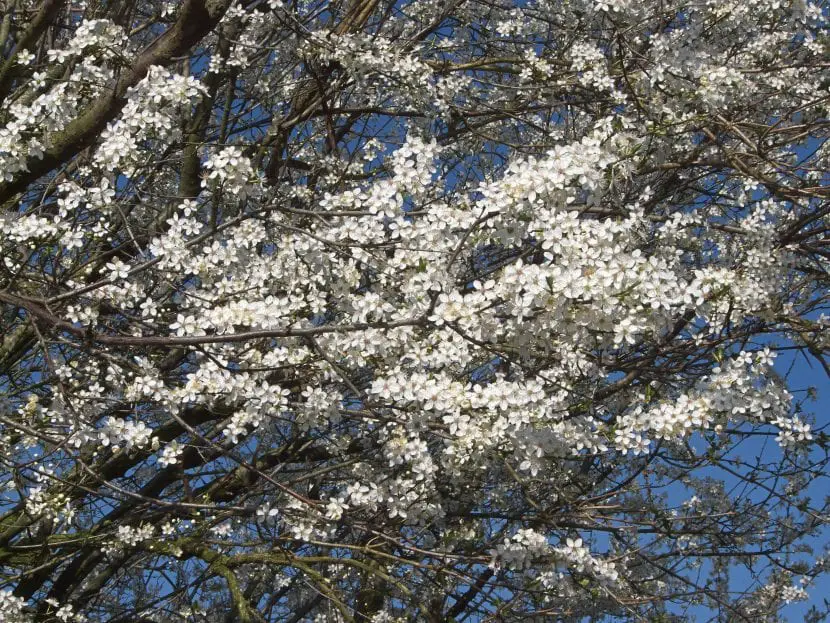

Image – Wikipedia, the free encyclopedia
Prunus are trees of great ornamental value, but there are many species and varieties that also produce edible fruits, and one of them is known as mirabels. This plant produces a type of plum, but smaller than the common one and yellow or red in color.
Its cultivation is very simpleas it resists frost without problems. In addition, it is not a species that needs to be pruned, which means that you will only have to worry about keeping it well watered and fertilized.
Origin and characteristics of the mirabelle


Image – Wikipedia, the free encyclopedia
It is a deciduous tree or sapling belonging to the genus Prunus originally from the Lorraine region, in France. Its scientific name is Prunus domestica var. Syriacalthough it is known as mirabelle, mirabelle, mirabelles, bells or bells, and grows to a height of about 5 to 7 metersbeing usual to leave it as a low shrub of about 3-4 meters. The leaves are ovate-lanceolate, petiolate, with the upper surface glabrous and the underside somewhat pubescent on the veins.
Blooms in spring. The flowers are solitary or sometimes in fascicles, white. The fruit is a drupe of about 4cm, globose, with yellow or red skin, and inside it contains a single brown seed.
What are their cares?
If you want to have a copy, we recommend you take care of it as follows:
Location
It is a plant that must be outside, in full sun. Although it does not grow much, it does need space to be able to develop well, so it must be planted at a minimum distance of two or three meters from walls, walls, tall plants, etc.
Earth
- Flower pot: It can be grown in large containers, with holes for drainage, using substrates rich in organic matter that are able to quickly filter the water. For example, a good mix would be 60% mulch (for sale here!) + 30% perlite (for sale here!) + 10% worm castings (for sale here!).
- Garden: the soil must be fertile, with good drainage.


Related article:
The importance of drainage for our plants
Irrigation


The frequency will vary depending on the climate and the location, but in principle should be moderate to frequent. During the summer and / or if it is hot and it hardly rains, it will be necessary to water very often, but the rest of the year, one or two waterings a week may be enough.
In any case, it is important that every time you water you soak the soil well. If it is planted in the garden or orchard, make a tree for it (it is like a low barrier, about 5cm high, made with earth, which forces the water to stay around the plant, with which it can absorb it all) and water consciously. On the other hand, if you have it in a pot, water until the water runs out of the drainage holes.
You should never wet the leaves, and less if the sun is high since they would burn and fall before their time.
Subscriber
During the warm months of the year It is necessary to fertilize the mirabeles with organic fertilizers, such as mulch, compost, guano (on sale here!), or the herbivorous animal manure.
Planting or transplanting time
You can plant it in the garden late winteror in autumn if the weather is mild. If you have it in a pot, transfer it to a larger one every 2 or 3 years.
Multiplication
The mirabeles multiplies by seeds in wintersince it needs to be cold before germinating. For this, what is done is to sow them in a tupperware with vermiculite (for sale here!) previously moistened, and then placed in the refrigerator – where dairy products, fruits, etc. are put – for three months.
Once a week you have to take the tupperware out of the fridge and open it to check that the substrate is still damp and, also, so that the air is renewed thus avoiding the appearance of fungi.
After that time, they are sown in a flower pot or seedling tray with mulch mixed with 30% perlite, and placed outside, in semi-shade. A) Yes, will germinate throughout the springmore or less four or eight weeks after sowing.
Pests and diseases of the mirabelle plum
It is quite resistant, but can be affected by aphids, San Jose lice, fruit fly, roya, gum y chancre. But they can be treated well with diatomaceous earth (for sale here!), and fungi with ecological fungicides such as copper or sulfur.
Harvest
Its fruits finish ripening between the end of August and the beginning of September.
Rusticity
It resists frosts of up to -15ºC.
What uses does it have?


Image – Wikipedia, the free encyclopedia
Apart from being used as an ornamental, it is also edible. However, its flavor is sweet, so it is usually used more to make other products, such as spirits, jams or the mirabelle cake, which is a typical sweet from Lorraine.
What did you think of this plant? Did you know her?
